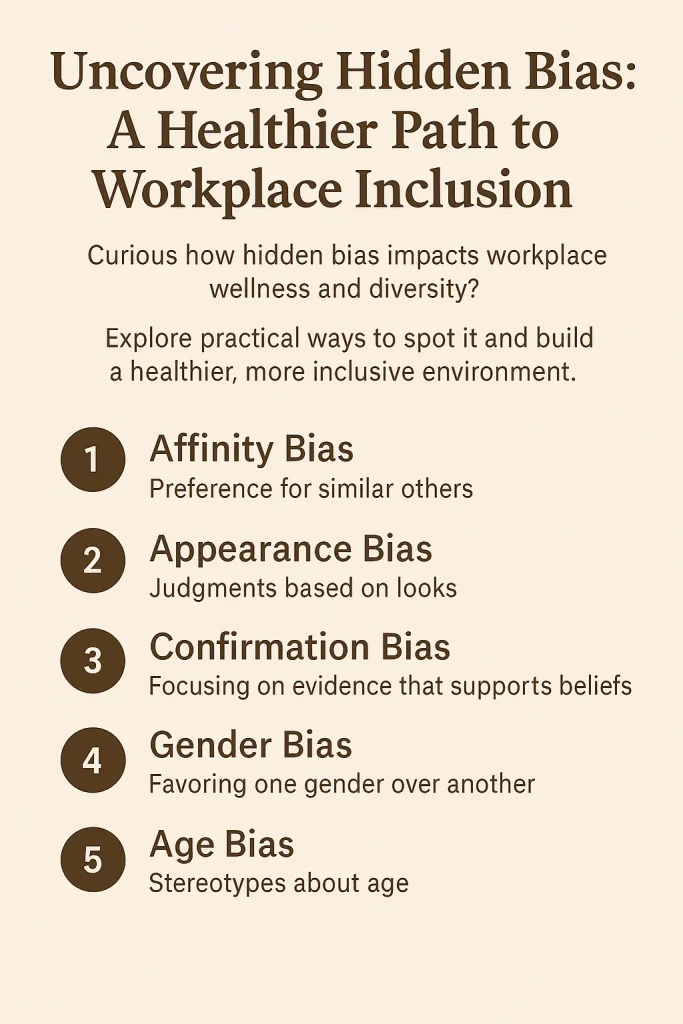Uncovering Hidden Bias: A Healthier Path to Workplace Inclusion
Curious how hidden bias impacts workplace wellness and diversity? Explore ways to spot it and build a healthier & inclusive environment.

With a growing number of organizations prioritizing diversity, equity, and inclusion (DEI), greater attention has been directed toward the presence of unconscious bias. Often embedded within workplace culture, unconscious bias—also referred to as implicit bias—represents automatic attitudes that influence responses to others. These biases may relate not only to age or gender but also to height, body size, or perceived attractiveness.
A significant influence on the overall workplace environment can be observed as a result of implicit bias. Retention, engagement, productivity, public image, and financial performance may all be affected. In a joint study conducted by Harvard Business Review and the University of Chicago, over 1,900 employees from large organizations were surveyed to explore perceptions of workplace bias. Those identifying such bias were found to be twice as unlikely to experience pride in their workplace, three times as likely to consider leaving within a year, and more than four times as likely to experience alienation.
Unconscious bias, rooted in unrecognized stereotypes, can be challenging to uncover. Still, steps can be taken to bring awareness and foster a more inclusive environment. Below are some frequently encountered forms of implicit bias, along with strategies designed to address them effectively in the workplace.
- Affinity Bias
Often referred to as similarity bias, this form of bias occurs when an individual is viewed more favorably due to shared traits such as background, interests, or appearance. For instance, during an interview, a positive impression may be formed simply because the candidate attended the same university.
Awareness of this tendency can be increased by reflecting on the reasons certain individuals feel more relatable. Feedback can be invited from others, and efforts can be made to connect with a diverse range of colleagues, including those whose views may differ. As often stated, “Growth begins at the edge of comfort zones.”
- Appearance Bias
This form of unconscious bias involves assumptions based on physical appearance. Traits such as hair color, body size, height, and perceived attractiveness may influence decisions. An academic review in Behavioral and Brain Sciences noted that those perceived as physically attractive are more likely to receive interviews, be hired, progress quickly in careers, and receive higher pay compared to others.
Encouragingly, this type of bias can be addressed with relative ease. Photographs and appearance-related data can be removed from application materials. A structured approach to candidate evaluation—beginning with standardized screening steps before face-to-face interaction—can reduce the effect of visual impressions. As shared in many professional settings, “Merit is best seen when vision is clear of distraction.”
- Confirmation Bias

This form of bias involves favoring information that supports existing beliefs while ignoring details that challenge them. Objectivity may be reduced, and decision-making can suffer as a result. For instance, during product research, results that do not support an expected outcome may be dismissed as exceptions, even when they reflect broader consumer patterns.
To lessen the impact of this bias, decisions can be guided by complete and balanced data. In hiring, assumptions based on names or educational backgrounds can be minimized by using consistent, skills-based questions. As often noted, “Truth is revealed not by what is expected, but by what is discovered.”
- Gender Bias
This type of unconscious bias involves favoring one gender over another, often resulting in unequal treatment. In many professional settings, certain genders receive preferential consideration. As highlighted in the Women in the Workplace study, women hold only 25% of C-suite roles. For every 100 men promoted from entry-level positions to management, only 87 women receive similar advancement.
This bias can be reduced through awareness and structured practices. Training programs may be introduced to help teams recognize and question unequal patterns. In hiring, neutral evaluation methods—such as blind skills assessments and work-based samples—can support more balanced outcomes. As commonly stated, “Fairness begins where assumptions end.”
- Age Bias
This form of bias, often referred to as ageism, involves unfavorable treatment based on age—affecting individuals across the age spectrum. Common examples include being overlooked for advancement due to age or being pressured toward early retirement.
To help reduce age bias, reverse mentorship programs may be introduced, allowing collaboration between newer and more experienced team members. Recognition based on performance rather than time served can also support a fairer environment. Job postings can be crafted with inclusive language, avoiding terms such as “young team” or phrasing tied to specific personal circumstances.
When left unaddressed, unconscious bias can hinder diversity, equity, inclusion, and overall workplace well-being. Awareness marks the beginning. Consistent effort strengthens the foundation. As shared often, “A thriving culture starts where every voice finds space to grow.”
